|
Family: Indicatoridae (honeyguides)
Life
> Eukaryotes >
Opisthokonta
> Metazoa (animals) >
Bilateria >
Deuterostomia > Chordata >
Craniata > Vertebrata (vertebrates) > Gnathostomata (jawed
vertebrates) > Teleostomi (teleost fish) > Osteichthyes (bony fish) > Class:
Sarcopterygii (lobe-finned
fish) > Stegocephalia (terrestrial
vertebrates) > Tetrapoda
(four-legged vertebrates) > Reptiliomorpha > Amniota >
Reptilia (reptiles) >
Romeriida > Diapsida > Archosauromorpha > Archosauria >
Dinosauria
(dinosaurs) > Saurischia > Theropoda (bipedal predatory dinosaurs) >
Coelurosauria > Maniraptora > Aves
(birds) > Order: Piciformes
Species indigenous to southern Africa
|
Indicator
indicator (Greater honeyguide) The Greater honeyguide occurs from Senegal through the Sahel to Ethiopia, extending south to many areas of southern Africa, where
it lives in a wide variety of habitats. It mainly eats bees' products, and
is famous for its tendency to lead humans to bees nests. It is a brood
parasite, laying in a wide variety of bird nests. The female lays its egg
while the hosts is out, destroying any existing eggs already in the nest. The eggs are laid in series
of 4-7, each in a different nest, laying about 21 eggs in the whole
breeding season. The chicks stays in the nest for roughly 38 days, after
which they are fed by the host for 7-30, usually 7-10 days after leaving. |
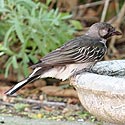 |
|
Indicator
meliphilus (Pallid honeyguide, Eastern honeyguide) |
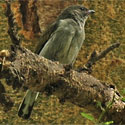 |
|
Indicator
minor (Lesser honeyguide) The Lesser honeyguide lives in
sub-Saharan Africa, absent for the dense forests and arid areas, but
otherwise occurring in a wide variety of habitats. It feeds on a wide range
of insects, as well as a Honeybees (Apis mellifera) and the honey
they produce. It is a brood parasite, laying mainly in barbets nests, laying
about 18-20 eggs in the whole breeding season. Soon after the chick hatches
it viciously kills the host birds chicks, with extraordinary strength. |
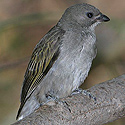 |
|
Indicator
variegatus (Scaly-throated honeyguide) |
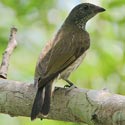 |
|
Prodotiscus
regulus (Brown-backed honeybird, Sharp-billed honeyguide) |
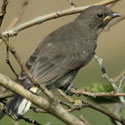 |
|
Prodotiscus
zambesiae (Green-backed honeybird, Slender-billed honeyguide) |
|
|
